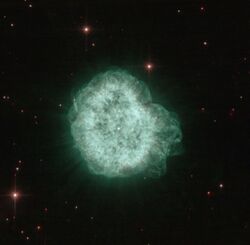Astronomy:NGC 2867
| Emission nebula | |
|---|---|
| Planetary nebula | |
 | |
| Observation data: J2000 epoch | |
| Right ascension | 09h 21m 25.38336s[1] |
| Declination | −58° 18′ 40.6167″[1] |
| Distance | 7,270 ly (2,228 pc)[2] ly |
| Apparent magnitude (V) | 9.7[3] |
| Apparent dimensions (V) | 12″[4] 43.3″ × 35.6″[5] |
| Constellation | Carina |
| Designations | ESO 126-8, PN G278.1-05.9,[6] Caldwell 90 |
NGC 2867 (also known as Caldwell 90) is an elliptical[5] Type II[7] planetary nebula in the southern constellation of Carina, just over a degree to the NNW of the star Iota Carinae.[8] It was discovered by John Herschel on April 1, 1834. Herschel initially thought he might have found a new planet, but on the following night he checked again and discovered it had not moved.[3] The nebula is located at a distance of 7,270 light-years from the Sun.[2]
The central star of the nebula is of spectral type WC3[9] and is in the process of evolving into a white dwarf, having previously shed the atmosphere that created the surrounding nebula. It is now a hydrogen deficient GW Vir variable that is undergoing non-radial pulsations with an amplitude of less than 0.3 in magnitude. The star has an estimated temperature of 165+18
−20 kK with 5% of the radius of the Sun and is radiating 1,400 times the Sun's luminosity.[5]
The surrounding nebula is fairly typical but does shows carbon enrichment, which suggests the progenitor star was not massive but did pass through third dredge-up. The category of central star has excited a very high degree of ionization in the nebula.[7] The shape of the nebula appears somewhat elongated, which may indicate an interaction with the surrounding interstellar matter. The nebula halo may be a recombination of two separate halos, which could indicate a peculiar mass-loss history.[10]
References
- ↑ 1.0 1.1 Brown, A. G. A. (August 2018). "Gaia Data Release 2: Summary of the contents and survey properties". Astronomy & Astrophysics 616: A1. doi:10.1051/0004-6361/201833051. Bibcode: 2018A&A...616A...1G. Gaia DR2 record for this source at VizieR.
- ↑ 2.0 2.1 Stanghellini, Letizia et al. (December 10, 2008). "The Magellanic Cloud Calibration of the Galactic Planetary Nebula Distance Scale". The Astrophysical Journal 689 (1): 194–202. doi:10.1086/592395. Bibcode: 2008ApJ...689..194S.
- ↑ 3.0 3.1 O'Meara, Stephen James (2016). Deep-Sky Companions: The Caldwell Objects. Cambridge University Press. p. 415. ISBN 9781107083974. https://books.google.com/books?id=MMfxDAAAQBAJ&pg=PA415.
- ↑ "SEDS Online NGC Catalogue". Results for NGC 2867. http://spider.seds.org/ngc/ngc.cgi?2867.
- ↑ 5.0 5.1 5.2 Keller, Graziela R. et al. (August 2014). "UV spectral analysis of very hot H-deficient [WCE]-type central stars of planetary nebulae: NGC 2867, NGC 5189, NGC 6905, Pb 6 and Sand 3". Monthly Notices of the Royal Astronomical Society 442 (2): 1379–1395. doi:10.1093/mnras/stu878. Bibcode: 2014MNRAS.442.1379K.
- ↑ "NGC 2867". SIMBAD. Centre de données astronomiques de Strasbourg. http://simbad.u-strasbg.fr/simbad/sim-basic?Ident=NGC+2867.
- ↑ 7.0 7.1 Aguilar, A.; Carramiñana, A., eds (July 2001). "Planetary Nebulae with [WR] nuclei". IX Latin American Regional IAU Meeting, "Focal Points in Latin American Astronomy", held in Tonantzintla, Mexico, Nov 9-13, 1998. 61. Bibcode: 2001RMxAC..11...61P.
- ↑ Sinnott, Roger W.; Perryman, Michael A. C. (1997). Millennium Star Atlas. 2. Sky Publishing Corporation and the European Space Agency. p. 994. ISBN 0-933346-83-2.
- ↑ Werner, K. et al. (June 1992). "A spectacular mass-loss event of the central star of Longmore 4.". Astronomy and Astrophysics 259: L69–L72. Bibcode: 1992A&A...259L..69W.
- ↑ Corradi, R. L. M. (2003). "Observations of Planetary Nebulae Haloes". in Kwok, Sun; Dopita, Michael; Sutherland, Ralph. Planetary Nebulae: Their Evolution and Role in the Universe, Proceedings of the 209th Symposium of the International Astronomical Union held at Canberra, Australia, 19-23 November, 2001. Astronomical Society of the Pacific. p. 447. Bibcode: 2003IAUS..209..447C.
External links
- The Hubble European Space Agency Information Centre – Hubble picture and information on NGC 2867
- NGC 2867 on WikiSky: DSS2, SDSS, GALEX, IRAS, Hydrogen α, X-Ray, Astrophoto, Sky Map, Articles and images
 |

